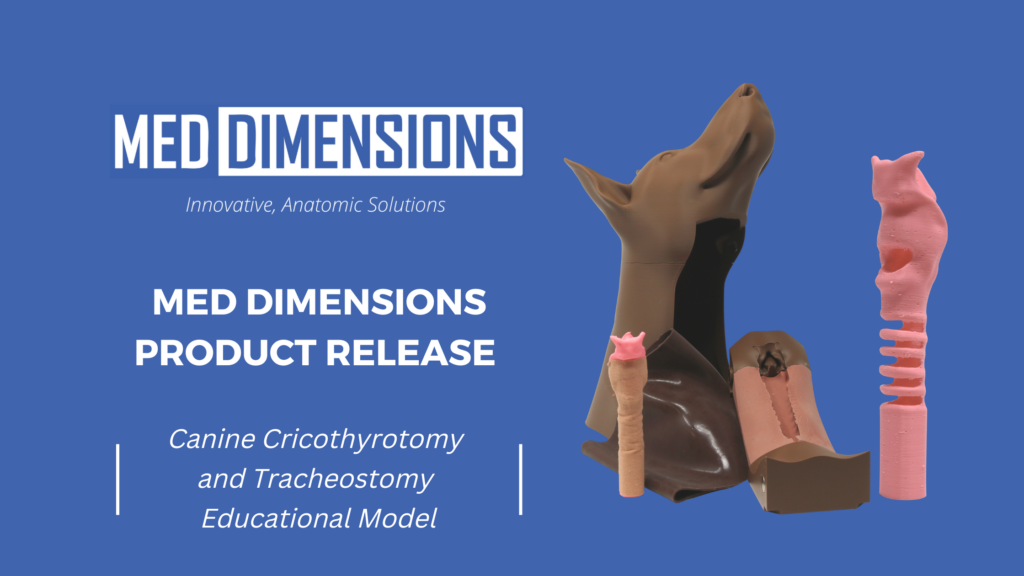Med Dimensions Product Release: Canine Cricothyrotomy And Tracheostomy Educational Model

In the ever-evolving landscape of veterinary education, Med Dimensions continues to push the boundaries with its latest innovation—the Canine Cricothyrotomy and Tracheostomy Educational Model. As we introduce these groundbreaking models, we also delve into the critical veterinary procedures they simulate, shedding light on the significance of mastering canine cricothyrotomy and tracheostomy techniques.
The Significance of Canine Cricothyrotomy and Tracheostomy:
- Emergency Airway Access: Canine cricothyrotomy and tracheostomy procedures are essential skills for veterinary professionals, especially in emergency situations where securing a clear airway is paramount. These techniques play a crucial role in facilitating breathing and administering life-saving interventions.
- Life-Saving Techniques: In cases of upper airway obstructions or severe respiratory distress, a prompt and effective cricothyrotomy or tracheostomy can be a life-saving measure. Veterinary professionals equipped with proficiency in these procedures can make critical decisions swiftly, ensuring the welfare of their canine patients.
- Skill Development for Veterinarians and Vet Techs: The Canine Cricothyrotomy and Tracheostomy Educational Models from Med Dimensions serve as invaluable tools for skill development. These models provide a realistic and hands-on training experience, allowing veterinarians and vet techs to practice and refine their techniques in a controlled environment.
Med Dimensions’ Canine Cricothyrotomy and Tracheostomy Educational Models: A Closer Look:
- Realistic Anatomy: The models are meticulously designed to replicate the canine anatomy, offering a true-to-life experience for practitioners. The inclusion of key anatomical features, such as the cricothyroid membrane and tracheal rings, ensures a high-fidelity training environment.
- Dynamic Functionality: The models feature dynamic functionality, allowing practitioners to simulate the step-by-step process of canine cricothyrotomy and tracheostomy. This hands-on experience enhances muscle memory and procedural confidence.
- Repeatable Practice: Med Dimensions’ commitment to excellence is evident in the durability of these models. Practitioners can perform the procedures multiple times, honing their skills through repeated, realistic practice sessions.
Mastering Canine Cricothyrotomy and Tracheostomy: Step by Step:
- Assessment and Decision-Making: The procedure begins with a swift assessment of the canine patient’s airway. In emergency situations, quick and decisive decision-making is crucial for determining the need for cricothyrotomy or tracheostomy.
- Anatomical Landmarks: Identifying the anatomical landmarks, including the cricothyroid membrane or tracheal rings, is the next step. The Canine Cricothyrotomy and Tracheostomy Educational Models provide practitioners with a tactile understanding of these landmarks, enhancing precision.
- Incision and Tube Placement: With the anatomical landmarks identified, the practitioner makes a precise incision to create an artificial airway. The insertion of a tube into the airway ensures a clear and secure pathway for breathing.
- Securing the Airway: Once the tube is in place, securing the airway becomes a priority. This step involves stabilizing the tube and monitoring the canine patient’s respiratory status.
- Post-Procedure Care: After successfully performing a cricothyrotomy or tracheostomy, practitioners must provide post-procedure care, including monitoring for complications and ensuring the stability of the artificial airway.
Conclusion: Elevating Canine Emergency Care Through Education
Med Dimensions’ Canine Cricothyrotomy and Tracheostomy Educational Models stand as a testament to the company’s commitment to advancing veterinary education. By offering a realistic and repeatable training experience, these models empower veterinary professionals to master life-saving techniques, ultimately enhancing the standard of care for their canine patients. As we embrace these innovative tools, we look forward to a future where every veterinary professional is equipped with the skills and confidence to navigate emergency airway access with expertise and precision.